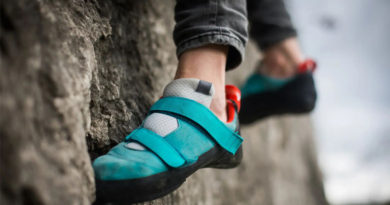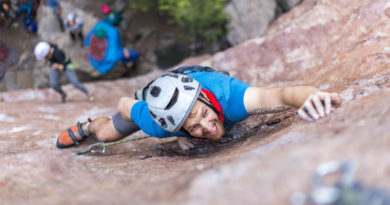Approach Shoes vs. Trail Runners: Know the Difference
Approach shoes are designed for hiking, climbing, and scrambling because they provide excellent grip and stability on rough terrain. They usually have sticky rubber soles for traction on rocks and a snug fit for precise foot placement. To protect your feet from sharp rocks and other hazards, approach shoes may also have reinforced toe caps and durable uppers. While they can be used for short distance running, they are not as flexible or cushioned as trail runners.
Trail runners or trail running shoes, on the other hand, are designed specifically for running on trails and uneven terrain. They are usually more cushioned and flexible than approach shoes. This allows for a more comfortable stride over long distances. Trail runners frequently have breathable uppers to keep your feet cool and dry, as well as lugged soles for traction on mud, dirt, and other loose surfaces. While they are appropriate for hiking and approach activities, they may not provide the same level of support and protection as approach shoes.
What are Approach Shoes?
Approach shoes are a type of outdoor footwear that is designed to provide excellent traction and stability on rocky terrain. They are commonly used for activities like hiking, scrambling, and climbing, which require the ability to move quickly and precisely over uneven and rocky terrain. Approach shoes are frequently referred to as a cross between hiking boots and rock climbing shoes, as they combine the durability and support of boots with the sticky rubber soles and precise fit of climbing shoes.
They have sticky rubber soles
One of the most important characteristics of approach shoes is their sticky rubber soles, which provide excellent traction on rocks, boulders, and difficult terrain. Approach shoes’ rubber is often softer and more flexible than that used in hiking boots or other outdoor footwear, allowing it to grip onto small edges and features. In addition, the soles may have specific patterns or lugs designed to provide traction on various types of surfaces.
Reinforced toe caps and durable uppers
Approach shoes, in addition to having grippy soles, often have reinforced toe caps and durable uppers to protect your feet from sharp rocks and other hazards. The uppers, which can be made of leather or synthetic fabrics, are designed to provide a snug fit that allows for precise foot placement. Many approach shoes have lacing systems that extend all the way down to the toes, allowing you to fine-tune the fit and tension of the shoe for maximum control.
Made for specific types of activities
Approach shoes are made for a specific type of activity, and they are optimized for grip and stability on rough terrain. They may not be as comfortable or cushioned as other types of outdoor footwear, making them less appropriate for long hikes or trail running. Approach shoes, on the other hand, are an excellent choice if you need a shoe that can handle technical terrain while also providing the grip and support required for scrambling or climbing.
What are Trail Runners?
Trail runners are a type of outdoor footwear specifically designed for running on trails. They are often used for activities such as hiking, backpacking, and trail running, where a shoe that can handle a variety of surfaces and conditions is required. Trail runners are lightweight, flexible, and cushioned, making them ideal for long-distance running and other endurance sports.
They are more cushioned
Cushioning is a key feature of trail runners. It helps to absorb the impact of each step and reduces strain on your joints. The amount of cushioning varies by brand and model, with some trail runners having no cushioning at all and others having a thick layer of foam or gel. Trail runners are also made to be flexible, allowing your foot to move naturally and adapt to the terrain’s contours.
They have lugged outsoles
Trail runners also have lugged soles, which provide excellent traction on mud, dirt, and other loose surfaces. Depending on the intended use of the shoe, the lugs may be deep or shallow, with deeper lugs providing more grip on loose or slippery terrain. To protect your feet from sharp rocks and other hazards, trail runners may have a rock plate or other protective layer in the sole.
Designed for running on uneven terrain
Trail runners are made for running on trails and uneven terrain, making them unsuitable for activities like scrambling or climbing. They may not provide as much support or protection as other types of outdoor footwear, making them less comfortable for long hikes or walks. Trail runners, on the other hand, are an excellent choice if you need a shoe that can handle a variety of surfaces and conditions while also providing the cushioning and flexibility required for running or other endurance activities.
Should you use Trail Runners for Scrambling or Climbing?
Trail running shoes are not the best choice for scrambling or climbing. While they are intended to handle uneven terrain and provide good traction on slick surfaces, they do not provide the same level of support, protection, or stability as approach shoes, which are designed specifically for these activities.
For edging and smearing on rock, scrambling and climbing require a shoe with a more precise fit and a stiffer sole. Approach shoes are built with these characteristics in mind, and their sticky rubber soles provide excellent traction on rock surfaces. Furthermore, approach shoes typically have reinforced toe caps and durable uppers to protect your feet from sharp rocks and other hazards.
If you intend to go scrambling or climbing, you should wear footwear that is specifically designed for these activities. While trail running shoes are appropriate for hiking and running on trails, they do not provide the support or protection required for scrambling or climbing. It is critical to select the appropriate shoe for the activity to ensure your safety and comfort.
Should you wear Approach Shoes for Trail Running?
While approach shoes are designed for scrambling and climbing on rugged terrain, they may not be the best choice for trail running. Approach shoes are heavier and less flexible than trail runners, making them less comfortable for long distance running.
Additionally, approach shoes may not be as cushioned as trail runners, which can increase the impact on your joints and cause discomfort or injury. Approach shoes’ soles are also stiffer and less flexible, making it more difficult for your feet to adjust to the contours of the terrain.
That said, if you’re used to running in approach shoes and prefer the extra support and protection they provide, there’s no reason you can’t use them for trail running. However, due to their lighter weight, cushioning, flexibility, and traction, trail runners are the better choice for most people when running on trails.
Conclusion
To conclude, approach shoes and trail runners are both popular types of outdoor footwear, each designed for a specific activity or terrain. Approach shoes are ideal for scrambling and climbing because they provide the necessary support, protection, and grip. Trail runners, on the other hand, are specifically designed for running on trails, with cushioning, flexibility, and traction.
It is critical to select the appropriate footwear for your activity to ensure your comfort, safety, and performance. While approach shoes may not be the best choice for trail running and vice versa, it is always worth considering the features and benefits of each type of shoe before making a decision.




